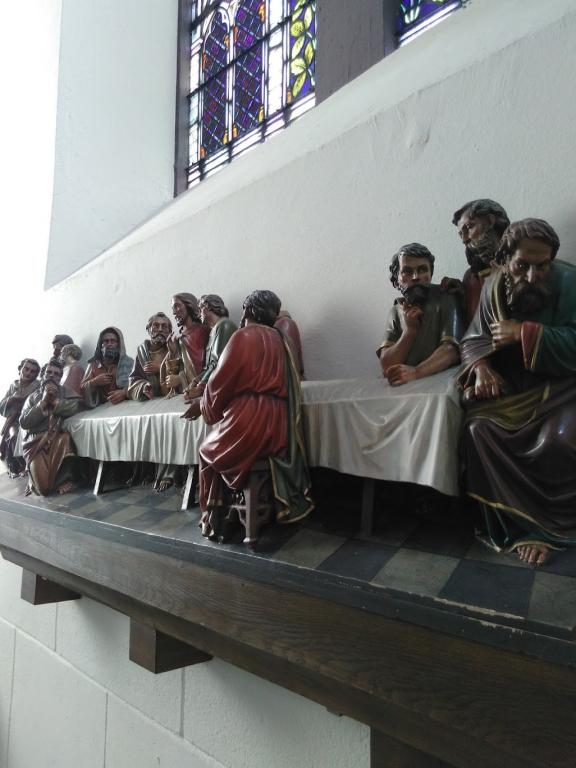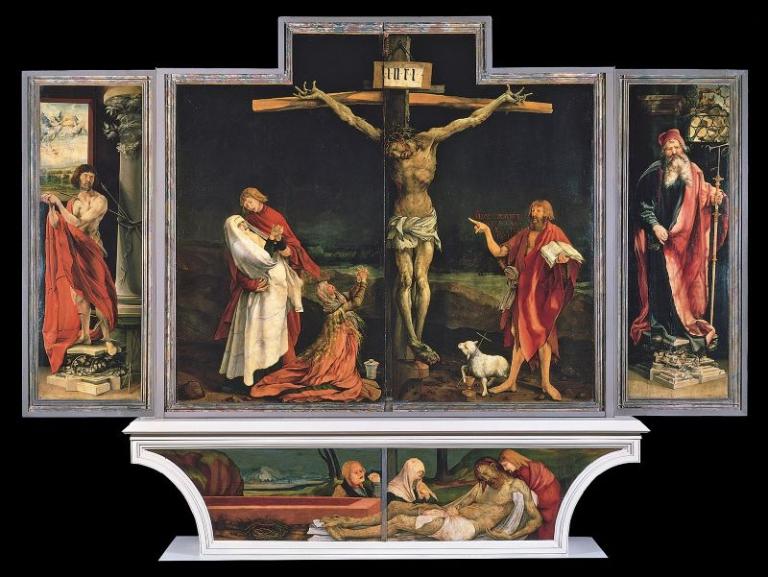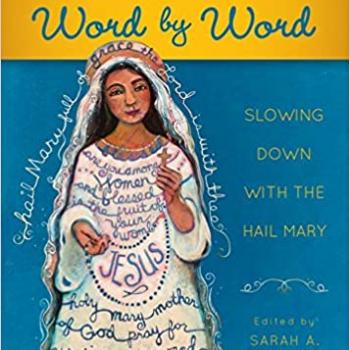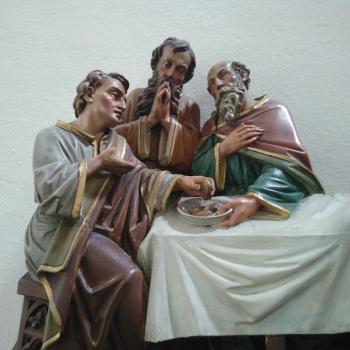The question I volunteered to cover today is: Why is Mel Gibson’s The Passion of the Christ considered a Catholic movie?
I’m going to run through some caveats first, and then look at ways the film is particularly consonant with Catholic spirituality; finally we’ll get down to the one non-negotiable that secures this movie its ultimate Catholic street cred.
#1 Oh my gosh it’s so violent.
Sometimes we say a movie is “Catholic” or “Christian” as code for “G-rated, with heartwarming themes.” The Passion is not that. It’s intensely, graphically violent. It’s intentionally unsettling.
Others have said so many times, but I will say it again: This is a film about a guy being tortured to death. The film is very, very good at not just producing the blood-and-guts, but at making it crystal clear, in a haunting and profoundly disturbing way, just how much Jesus suffered, and just how deeply those around him may have experienced fear, torment, despair, rage, callousness . . . it is a very dark film.
–> Not only would I say that children shouldn’t view it, I’d say that adult viewers should think carefully about whether this film is for them.
So our definition of Catholic in this context isn’t “universal” in the sense of “everyone should see this film.” Nope. Many people should absolutely not view this film, not ever. But there are solid reasons The Passion is firmly a “Catholic” film in a more precise sense of the term.
#2 Is Mel Gibson even Catholic?
As we found doing an assessment of the religious faith of Taylor Swift, it’s not always easy to know exactly what a given artist believes. Mel Gibson’s Catholic faith has at times seemed to run off the rails, and I’m hesitant to go deeply into the guesswork on the precise state of his soul.
I think the best summary of where he currently stands, as far as can be known, was put together by fellow Patheos blogger Kate O’Hare, who is in a much better position to assess Gibson’s religious situation, and who looked into the topic last spring: “Is Mel Gibson a Traditionalist Catholic?”
But the deeper question is this: Do you need to be Catholic, or a certain kind of Catholic, to create a Catholic film?
For slightly-lighter (but still not sweet and kid-friendly) fodder on what makes a “Catholic” film, here are two essays on the Catholicism, or lack of it, of Guillermo del Toro’s Pinocchio, currently streaming on Netflix:
Del Toro employed intensely, explicitly Catholic themes in the film, but he didn’t claim, at all, to be Catholic himself — though from the sound of it he has a childhood religious upbringing not unlike Mel Gibson’s.
And thus here’s the rub: Whether an artistic work can be called “Catholic” depends not only on the artist’s personal religious views, but also on the vision and themes of the work, and also on the perceptions and experiences of the audience.
Regardless of Mel Gibson’s personal beliefs and practices, which are not always completely in line with the entirety of Catholic teaching, The Passion of the Christ finds itself landing in “Catholic” territory both by the artist’s intent and what we the Catholic audience receive from it.
But again: That doesn’t mean everyone should watch this film. It does mean, though, that for some of us it can be a very powerful aid to the spiritual life.
#3 How does The Passion fit into the Catholic spiritual tradition?
Fundamentally, Mel Gibson’s Passion is part of the millennia-old Christian tradition of meditating on the suffering of Jesus Christ for the salvation of the world. That is what the film is about. In doing so, it draws on three big currents in Christian art: The Stations of the Cross, medieval mystery plays, and inculturation.
The Stations of the Cross The “stations” are a longstanding Christian practice of spiritually walking with Jesus from the moment of His condemnation to His death on the Cross. If you visit a Catholic parish church, you will usually find each of the fourteen traditional scenes, or “stations”, laid out in order in a path around the walls of the worship space. (Sometimes they are highly stylized and more difficult to see). During Lent — but also Advent! — it is traditional to pray the stations.
Mel Gibson’s Passion intentionally follows the traditional sequence of those fourteen stations.
Photo: The Last Supper carving at the Catholic parish church in Munster, Alsace (photo credit: Jennifer Fitz). Gibson has a great workaround in the film for harmonizing the conflict between ancient Jewish dining habits versus the later traditional European depictions of that moment.
Related: Here is a review of my most-recommended Stations of the Cross book.
Mystery Plays were medieval reenactments of spiritual or moral tales, built on Biblical themes but including inventive comedy and drama. Here’s a description of the York Mystery Plays as an example. Gibson’s Passion is a mystery play. It is not a strict Biblical retelling like the 2003 Gospel of John, nor does it limit itself to only those editorial decisions needed to flesh out the scriptural text.
Rather, Gibson quite freely develops possible “it might have happened this way” scenes that are purely the artist’s invention. The film holds onto its Catholic bona fides because all of those inventions are consistent with the realm of possibility within the Catholic spiritual reality.
Inculturation is the adaption of the Christian faith to its cultural context without changing that faith. This can be simple, obvious adaptations such a basic language-translation. It includes Christian music, including liturgical music, created in the style of the local culture. It also includes the long and ancient practice of creating Christian art in the manner of the art and culture of the current time and place.
Salvador Dali’s 1955 The Sacrament of the Last Supper, for example, is in no way an effort to be an exact depiction of the historical event; rather it is a seeing of the event through the cultural lens of the artist, in a symbolic language that speaks to the understanding of the contemporary viewer.
For another example, Amy Welborn recently linked to this article on “Jesus Christ through lens of traditional Korean culture” and the piece she chose to close her own essay with is an example of why inculturation is so important: There are so many women in the nativity scene! I’m used to traditional western depictions that often confine themselves to the characters explicitly called out in the Biblical text, but of course Mary would have been assisted by the women of the neighborhood in the days following the birth of Jesus. That just makes sense.
Gibson’s Passion, meanwhile, poses a different question: What if we view those last hours of the life of Christ through the lens of the same cultural context and art form that brought us Braveheart and Lethal Weapon?
Just as Peter Jackson was able to so eloquently convey the horror of Mordor in his take on Tolkien’s ring trilogy because he comes from the horror-movie tradition, Mel Gibson was supremely prepared to convey the horror and violence of the betrayal and killing of Christ because that artform is his trade.
#4 What does Catholicism boil down to anyway?
Ultimately The Passion of the Christ is a Catholic movie because of its faithfulness to the final punchline of Gospels: Because of the Resurrection of Christ, death is not the end.
Everyone we know is going to die. That moment can be either a source of permanent loss, suffering, and despair, or it can be a moment of blessed hope.
To be Catholic is to know that we are not destined either for annihilation nor for the nebulous darkness of the ancient mythological underworlds. We suffer now in this life, just as Christ suffered for us, but because of His suffering, we too can be raised to eternal life and perfect happiness, if we will only place our faith in Him.
The Passion depicts this reality starkly and with extreme intensity. For many of us, the film serves (when we’re ready for such a thing) as just the spiritual jolt we need. For others, the movie is far too traumatically violent a depiction to be of any help.
So whether any given Catholic should watch the film is purely a personal call. But the Catholicism of the film does not depend on the faithfulness of its director, nor on the final historical veracity of each and every scene, but rather on the fact that it holds unwaveringly to the essential facts of the Christian faith laid out in the creeds.
Artwork: The Isenheim Altarpiece, crucifixion view. This is a classic example of how artists through the centuries have explored the suffering of Christ in shocking and disturbing forms — not for sensationalism, but because we need to know we aren’t alone. It can be viewed in person at the Unterlinden Museum, and seriously? If you are in that corner of the world, just go.
















